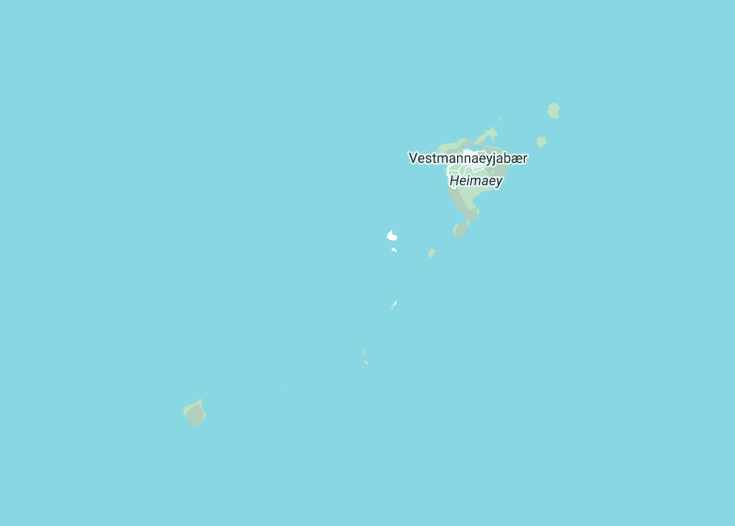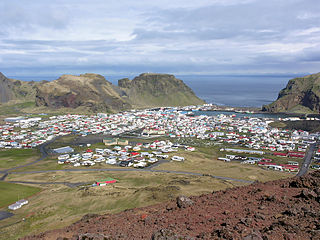Vestmannaeyjar, also known as the Westman Islands, is an enchanting archipelago off the southern coast of Iceland, renowned for its breathtaking landscapes and rich maritime history. These islands are a haven for nature enthusiasts and bird watchers, boasting unique volcanic scenery and an abundance of wildlife. The largest island, Heimaey, provides a captivating glimpse into resilient island life, having survived a devastating volcanic eruption in 1973 which reshaped the community and the physical landscape. Vestmannaeyjar offers an unforgettable experience with its stark natural beauty, cultural heritage, and vibrant wildlife.
Check the weather forecast and pack accordingly; the climate in Vestmannaeyjar can be quite unpredictable, ranging from sunny skies to sudden fog and rain.
Plan a visit during the summer to experience the Vestmannaeyjar Festival and witness the island at its most lively, with local music, cultural displays, and traditional foods.
Top destinations in Vestmannaeyjar (Iceland)
Vestmannaeyjar: A volcanic wonderland
| Country | Iceland |
| Time in Vestmannaeyjar | GMT-0 |
| Language spoken | Icelandic |
| Population | 4,135 (Statistics Iceland, 2021) |
| Currency | Icelandic króna (ISK) |
| Airports |
|
Located off the south coast of Iceland, Vestmannaeyjar, also known as the Westman Islands, is a stunning archipelago formed by underwater volcanic eruptions. The principal and most populous island, Heimaey, boasts a rich history that dates back to the 8th century when it was first settled by Irish monks. Disaster struck in 1973 when a massive eruption forced the entire population to evacuate overnight.
Despite its harsh landscapes, Vestmannaeyjar is known for its vibrant wildlife, including puffins, and its dramatic ocean views. The islands offer a unique blend of natural beauty and cultural heritage, making them a must-visit for nature enthusiasts and history buffs alike. Various boat tours and hiking opportunities allow visitors to explore the rugged terrain and learn about the island’s compelling volcanic past.
The annual Þjóðhátíð festival, which commemorates the island’s survival from the 1973 eruption, draws large crowds with its music performances and traditional Icelandic festivities. Vestmannaeyjar is not just about natural beauty; it is a place of survival and resilience, providing visitors with a profound sense of place and history.
Where is Vestmannaeyjar?
Vestmannaeyjar lies approximately 7.4 miles (about 12 km) off the southern coast of Iceland, easily accessible by ferry or plane.
Distances:
| Route | Distance by car | Time by car |
|---|---|---|
| Iceland to Vestmannaeyjar ferry terminal | 80 miles / 129 km | 1 hour 15 minutes |
What is Vestmannaeyjar famous for?
Vestmannaeyjar is famous for its dramatic volcanic history and large puffin colony. The island of Heimaey, part of the archipelago, is particularly noted for its scenic beauty and rich historical tapestry, including the dramatic 1973 Eldfell volcanic eruption.
History
874-1627: Formation and Early Settlement
Vestmannaeyjar, or the Westman Islands, located off the south coast of Iceland, were first discovered and settled around 874 AD by Norse settlers escaping the turbulent political climate of Scandinavia. The name ‘Vestmannaeyjar’ translates to ‘islands of the Westmen’, a term used by the Norse to denote people from the British Isles, some of whom were brought to the islands as slaves. Over the centuries, these islands developed as a fishing and naval outpost, crucial for their geographical position and abundance of natural resources.
1627-1900: Pirate Attacks and Community Consolidation
In 1627, Vestmannaeyjar faced a major crisis known as the Algerian pirate raid. Pirates from North Africa, under the command of Dutch renegade Jan Janszoon, attacked the islands, enslaving nearly 400 inhabitants and disrupting the islands’ tranquility and development. This event is deeply ingrained in the local history and is remembered as the ‘Turkish Abduction’. Following this period, the islands slowly recuperated, focusing on maritime industries, particularly fishing, while enduring the hardships of volcanic activity and isolation.
1900-Present: Modern Developments and Volcanic Event
The 20th century brought significant change and challenges to Vestmannaeyjar. The event that marked recent history the most occurred in 1973, with the unexpected eruption of the Eldfell volcano. This eruption led to the evacuation of the entire population to mainland Iceland, and about one-third of the town was destroyed by lava flow. Remarkably, the community’s resilience shone through as most of the inhabitants returned and rebuilt the town. Today, Vestmannaeyjar is not only a key center for the Icelandic fishing industry but also a hub for scientific research into volcanology and a growing tourist destination, praised for its natural beauty and unique history.
Visit Vestmannaeyjar
What to see and do in Vestmannaeyjar, Iceland
Visiting Vestmannaeyjar offers a unique opportunity to explore a blend of natural wonders and rich history. Key attractions include:
- The Eldheimar Museum, dedicated to the 1973 volcanic eruption, providing interactive experiences.
- Heimaey, the largest island, known for its breathtaking landscapes and wildlife, particularly puffins.
- Sæheimar Aquarium, ideal for families, focusing on local marine life and the famous rescue puffin, Tóti.
- Outdoor activities like hiking Eldfell volcano for panoramic views or taking boat tours around the islands to explore sea caves and spot seals.
Additionally, golf enthusiasts can enjoy a unique experience at the Vestmannaeyjar Golf Club, ranked among the most picturesque courses in the world. The island’s small but vibrant town center offers local culinary delights, focusing on fresh seafood.
Festivals and Celebrations in Vestmannaeyjar
Vestmannaeyjar is renowned for its lively annual festival, Þjóðhátíð, held during the first weekend of August. This multi-day outdoor music festival, celebrated since 1874, features a stunning firework show, singing traditional songs, and a communal bonfire, drawing both locals and visitors into a spirited celebration of Icelandic culture. Additionally, the Puffin and Volcano festival highlights the island’s natural heritage and takes place every May, offering educational and fun activities related to its iconic wildlife and volcanic history.
Best time to visit Vestmannaeyjar
The ideal time to visit Vestmannaeyjar is during the summer months, from June to August, when the weather is mildest, and the wildlife, especially the puffins, are most active. This period also coincides with the island’s festive events, maximizing the cultural experience for visitors.
is Vestmannaeyjar worth visiting?
Indeed, Vestmannaeyjar is worth visiting for its unique combination of natural beauty, fascinating geological and historical sites, and the warm hospitality of its people. Whether it’s exploring the aftermath of a volcanic eruption, observing puffins in their natural habitat, or immersing oneself in local traditions at the annual festivals, Vestmannaeyjar offers an enriching and unforgettable experience. Its distinct charm makes it a gem within Iceland’s tourist attractions.















